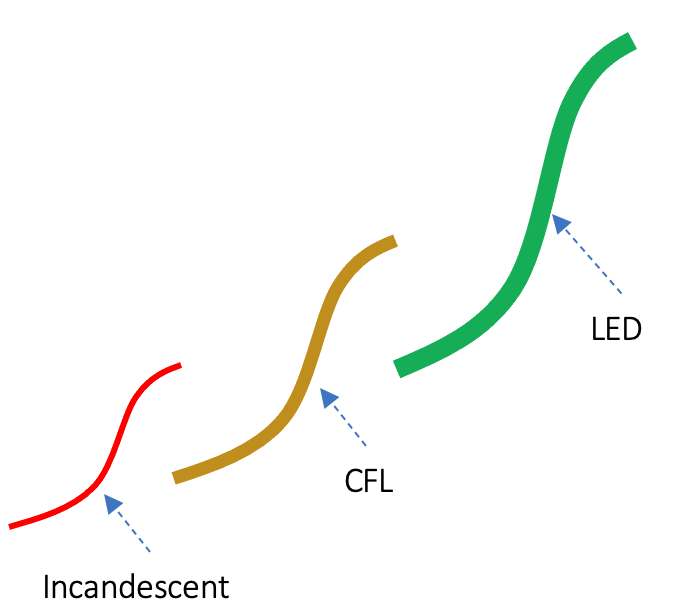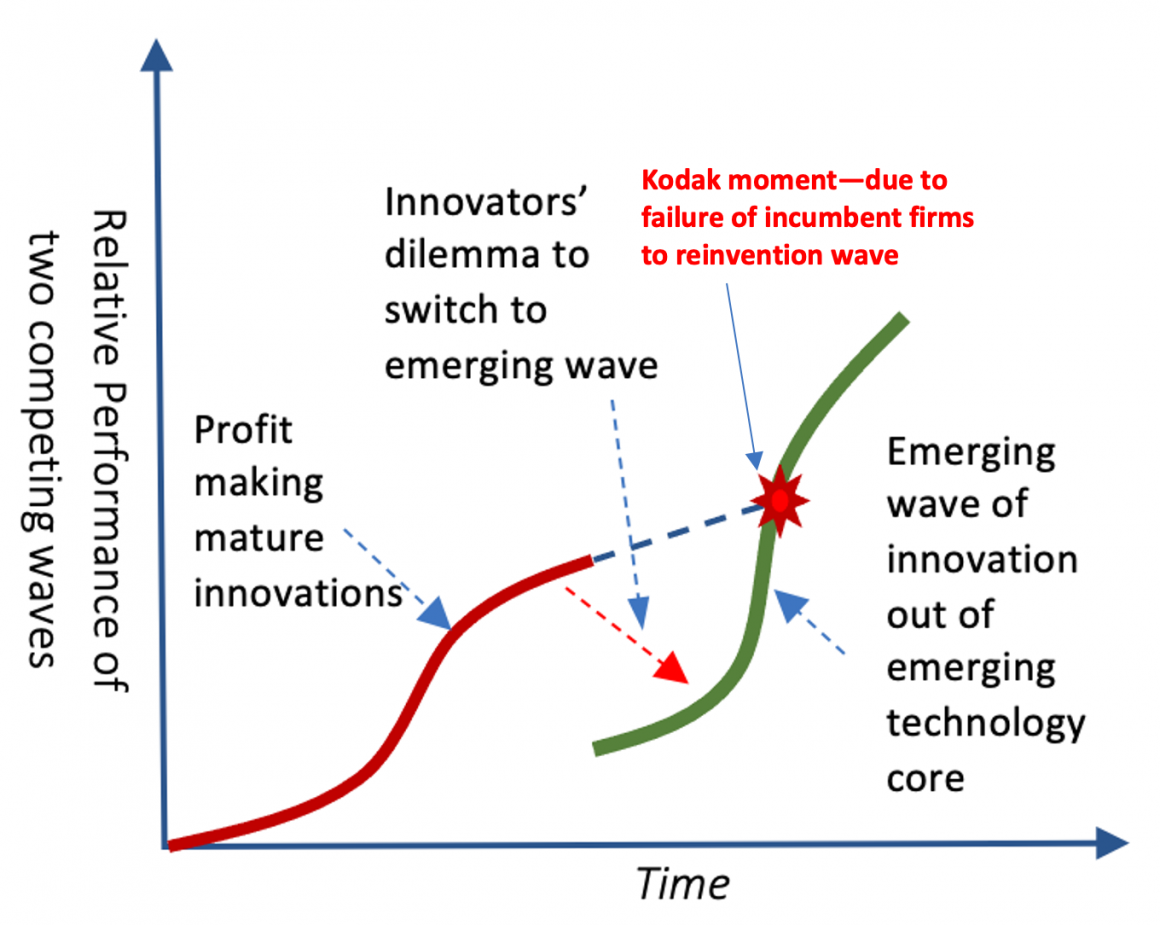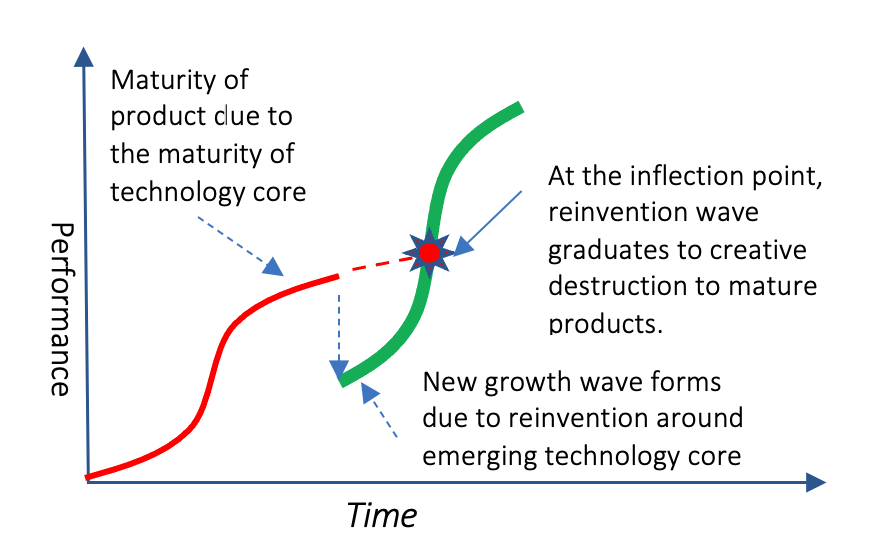Instead of going to video rental stores, we click a button to enjoy on-demand videos. Similarly, physical books have become e-Book, and streaming has taken over CD albums due to Creative Destruction. Creative destruction emerges due to the Reinvention of existing products through the change of the technology core. In the reinvention of many products, digitization and connectivity technology core have taken over the roles of materials and physical travels. But physical technology core could also take the part of the reinvention. For example, electric batteries and motors have been taking over the internal combustion engine and gasoline role in reinventing gasoline automobiles into electric vehicles. In addition to giving new growth paths to mature products, creative destruction also kills and creates jobs, creating stress on society. Due to it, small Startups grow as giants by destroying once giants. Hence, Creative destruction is a powerful Innovation strategy.
Defining Creative Destruction:
Product invention emerges around technology cores. For example, Automobile intention took place having gasoline engine as the technology core. Similarly, light bulb invention took place having filament as the core technology. All the products we use have technology cores. Invariably, those technology cores mature, so do innovations around them. Hence, to create a new wave of growth, we reinvent them by changing the technology cores. Perhaps, many of the products we use now have already gone through reinvention, in some cases more than once. In the early stage of the technology lifecycle, innovators embark on reinvention. Hence, invariably, innovations around reinventions emerge as inferior alternatives.

However, due to the amenability of advancement of technology core out of R&D, those inferior alternatives start growing as new waves. In some instances, those new waves keep growing, reaching, and passing through the inflection points. Consequentially, once inferior alternatives, born out of reinvention, become better substitutes, causing destruction to the demand of once superior mature products, giving birth to creative destruction concept. Prof. Schumpeter articulated in the 1950s. Hence, it’s also called Schumpeter’s creative destruction or Schumpeter’s gale. It drives the process of industrial mutation that incessantly revolutionizes the economic structure from within, incessantly destroying the old one.
However, the release of successive better versions keeps making previous versions of the same product obsolete. Hence, at a micro level, the obsolesce caused by the release of a better version around the same technology core could also be termed creative destruction. But in this article, we will term the wave formed out of reinvention passing through the inflection point, offering us a better alternative to incumbent mature products, as the creative destruction.
Examples of creative destruction:
There are numerous examples of creative destruction all around us. For example, LED light bulb has been creative destruction to incandescent and CFL light bulbs. Multi-touch-based smartphones caused destruction to keyboard-centric design. Here are further examples:
- LCD/LED television caused destruction to CRT-based ones.
- Transistor radio and television destroyed vacuum tube-based alternatives.
- The smartphone camera has been destructive to standalone still and video cameras
- The change of film with an image sensor is an example of creative destruction.
Like many others, of course, Netflix is creative destruction as digitization of films and its delivery over the Internet has caused destruction to tape-based film recording and its rental services. Similarly, Amazon is an excellent example of creative destruction due to its success in reinventions of Books, Retailing, and IT infrastructure as eBooks, e-Commerce, and Cloud services.

Characteristics:
Change of mature technology core of existing products with emerging one is the genesis of creative destruction. Hence, the wave of destruction force begins at the early stage of the technology lifecycle. Therefore, invariably, the reinvented versions show up in primitive form, inferior alternative. To cause destruction to the demand of mature counterparts, underlying technology core should keep progressing, making primitive alternatives increasingly better. Unless this new wave reaches the inflection point, it does not turn out to be a creative destruction force.
For example, LED technology core showed the promise of reinventing electric light bulbs. But the reinvention, in the 1980s, showed up as a primitive alternative. Light from the LED bulb was neither white nor bright. Furthermore, the cost was very high. Hence, innovators had to improve the LED technology core further to reach the inflection point at which customers found reinvented light bulbs better than filament or CFL counterparts. Until that point, the LED light bulb wave did not succeed to unleash its destructive effect. Hence, not all reinvention waves grow as a creative destruction force. Similarly, in the 1990s, on-demand movie delivery as digital content over the internet was a primitive alternative. The advancement of internet speed played a vital in fueling the primitive beginning into a force of destruction.
Role of creative destruction and its merits:
The role of creative destruction is to create a new growth wave out of the reinvention of existing ripe products by changing the mature technology core with emerging ones. As new waves of reinvention out of emerging technology core leads to offering a better alternative, consuming and polluting less, of course, creative destruction is good for us. In fact, due to it, we have been overcoming the growth limits set by mature technology core. For example, the destruction caused by the LED light bulb to incandescent one has been an excellent help for producing better quality light by consuming fewer resources and causing less pollution.
But despite the merit, creative destruction causes short-term havoc. As the emerging wave out of reinvention makes mature technology products obsolete, it leads to loss of demand of certain materials, the disappearance of jobs, and the destruction of firms. For example, a creative wave of destruction out of the electric vehicle (EV) will likely cause harm to the oil economy and jobs in making many mechanical components for the automobile. Perhaps, India will suffer from a loss of as high as 18 million automobile manufacturing jobs, as EV will require far fewer mechanical components. Hence, we need to predict and adjust our response to the creative dynamics out of destruction accordingly to minimize the bad side.

Effect of creative destructions on firms and unemployment:
In addition to offering a new growth path to maturing products, creative destruction also cause havoc. Due to obsolesce of mature products, it creates unemployment and causes destruction to firms involved in producing those products.
Due to lack of timely response and switching to emerging waves, reinvention wave may take the form of Disruptive innovation, causing harm to incumbent harms. Even certain economies, as a whole, may suffer from massive burns. For example, due to inappropriate response to the recreation of cameras as digital devices, Kodak disappeared giving birth to Kodak moment. There are many such examples. Due to it, innovations migrate from inventing countries to followers. Hence, it also becomes a blessing for the companies and economies in driving new waves of reinvention. However, not in all cases do new waves succeed as a destructive force.
Lifecycles of more or less all products take the shape of a typical S-curve. Invariably, our progress in improving the quality and reducing the cost reaches saturation. Creative destruction out of reinvention is our core strategic strength in addressing the growth limit of the evolution of products. In the absence of it, society will run out of its strength to keep extracting increasing economic value from the same unit of inputs.
...welcome to join us. We are on a mission to develop an enlightened community by sharing the insights of Wealth creation out of technology possibilities as reoccuring patters. If you like the article, you may encourage us by sharing it through social media to enlighten others.




